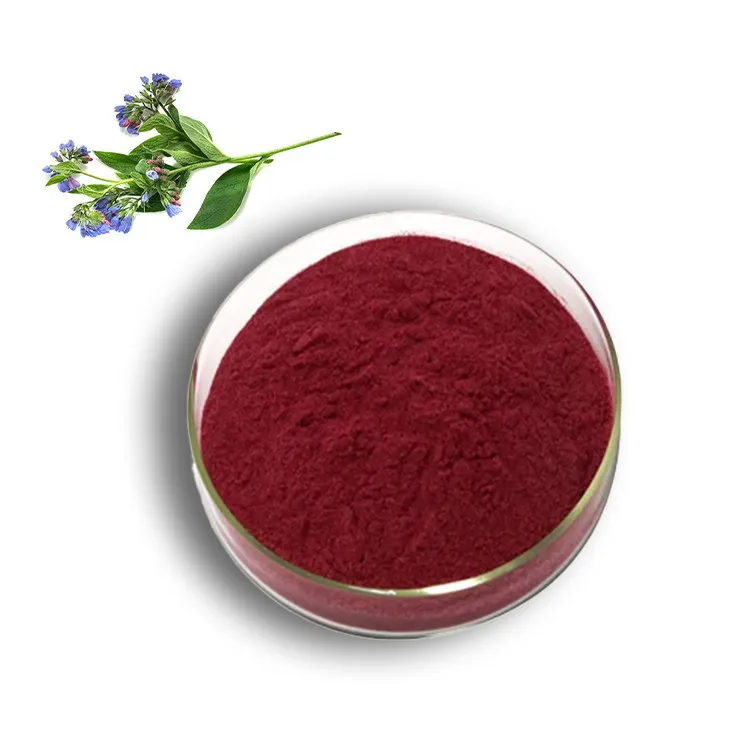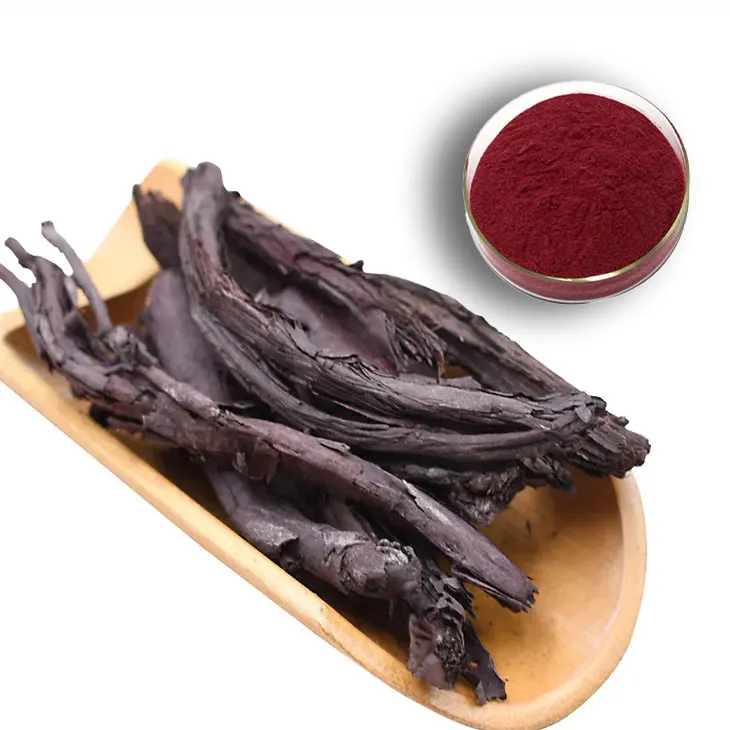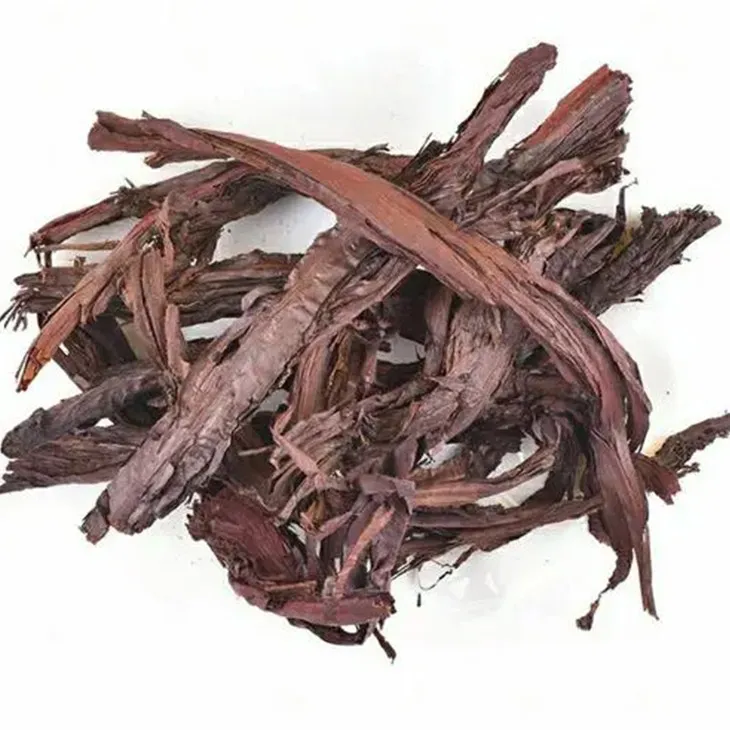- 0086-571-85302990
- sales@greenskybio.com
Components of Shikonin in Fertilizers and Feeds.
2024-11-28

1. Introduction
Shikonin is a natural compound that has recently emerged as a compound of great interest in both the fertilizer and feed industries. Natural compounds often possess unique properties that can be harnessed for various applications. Shikonin, in particular, has shown potential in enhancing different aspects related to plant growth in fertilizers and animal well - being in feeds.

2. Shikonin in Fertilizers
2.1 Soil Quality Enhancement
One of the key roles of shikonin in fertilizers is its ability to enhance soil quality. Shikonin - containing fertilizers can have a positive impact on the soil structure. It helps in binding soil particles together, which in turn improves soil porosity. This increased porosity allows for better air circulation within the soil. Adequate air circulation is crucial for the survival and activity of soil - dwelling organisms such as earthworms and beneficial bacteria.
Moreover, shikonin can also influence the soil's water - holding capacity. It can modify the soil's physical properties in such a way that it can retain water more effectively. This is especially important in areas with irregular rainfall patterns or in arid regions where water conservation in the soil is vital for plant growth.
2.2 Nutrient Uptake by Plants
Shikonin plays an important role in facilitating nutrient uptake by plants. It can interact with plant roots in a way that enhances the root's ability to absorb essential nutrients. For example, it can increase the root's surface area available for nutrient absorption. This is achieved through promoting root hair growth. Longer and more numerous root hairs can cover a larger area of the soil, thereby coming into contact with more nutrients.
Furthermore, shikonin can also influence the activity of membrane - bound transporters in plant roots. These transporters are responsible for moving nutrients from the soil into the plant cells. By modulating the activity of these transporters, shikonin can ensure that plants are able to take up nutrients more efficiently. This includes macronutrients such as nitrogen, phosphorus, and potassium, as well as micronutrients like iron, zinc, and manganese.

3. Shikonin in Feeds
3.1 Animal Health Benefits
When it comes to feeds, shikonin offers several benefits for animal health. It has been shown to possess antioxidant properties. In animals, oxidative stress can lead to various health problems, including cell damage, reduced immune function, and increased susceptibility to diseases. Shikonin can scavenge free radicals in the animal's body, thereby reducing oxidative stress and protecting cells from damage.
Shikonin also has anti - inflammatory properties. Inflammation in animals can be caused by a variety of factors, such as infections, injuries, or dietary imbalances. Chronic inflammation can lead to reduced growth performance and overall well - being. By reducing inflammation, shikonin can help animals maintain a healthy state and improve their resistance to diseases.
3.2 Growth Performance Improvement
Shikonin can contribute to the growth performance of animals. It can enhance the efficiency of nutrient utilization in animals. This means that animals are able to extract more energy and nutrients from the feed they consume. For example, it can improve the digestion and absorption of proteins, fats, and carbohydrates in the animal's digestive tract.
Moreover, shikonin can also stimulate the animal's appetite. A good appetite is essential for animals to consume an adequate amount of feed, which is necessary for their growth and development. By increasing the animal's appetite, shikonin can ensure that animals are getting enough nutrients to support their growth.

4. Production and Extraction of Shikonin
4.1 Natural Sources
Shikonin is mainly sourced from certain plants. Arnebia euchroma and Lithospermum erythrorhizon are two of the well - known plant sources of shikonin. These plants are typically grown in specific regions. For example, Arnebia euchroma is native to parts of Asia. The extraction of shikonin from these plants involves several steps.
First, the plant material is harvested. Then, it is dried and ground into a fine powder. The powder is then subjected to extraction processes, which often involve the use of solvents such as ethanol or methanol. The solvent - based extraction helps to isolate shikonin from other plant components.
4.2 Synthetic Production
In addition to natural extraction, there is also research being conducted on the synthetic production of shikonin. Synthetic production can offer certain advantages, such as a more consistent supply of shikonin. However, it also poses challenges in terms of cost - effectiveness and ensuring that the synthetically produced shikonin has the same properties as the naturally - sourced compound.
5. Safety and Regulatory Considerations
5.1 Safety for Plants and Animals
When considering the use of shikonin in fertilizers and feeds, safety is of utmost importance. For plants, extensive testing has been carried out to ensure that shikonin - containing fertilizers do not have any adverse effects on plant growth. In general, when used at appropriate concentrations, shikonin has been shown to be beneficial rather than harmful to plants.
Similarly, for animals, safety studies have been conducted to evaluate the impact of shikonin in feeds. These studies have focused on aspects such as toxicity, long - term health effects, and potential interactions with other feed components. So far, the results indicate that shikonin can be safely incorporated into animal feeds at appropriate levels.
5.2 Regulatory Aspects
The use of shikonin in fertilizers and feeds is also subject to regulatory requirements. Different countries and regions have their own regulations regarding the use of new components in agricultural products. These regulations are in place to protect the environment, human health, and the safety of agricultural products.
For example, in the European Union, any new ingredient in fertilizers or feeds must go through a rigorous approval process. This process includes safety evaluations, environmental impact assessments, and compliance with quality standards. In the United States, similar regulatory mechanisms are in place to ensure the safe and proper use of shikonin in these industries.
6. Future Prospects
The future looks promising for shikonin in the fertilizer and feed industries. Research and development efforts are likely to continue in order to further explore the potential of shikonin. There is potential for the development of more efficient extraction methods, which could reduce the cost of shikonin production.
Moreover, there is scope for formulating new fertilizers and feeds that contain shikonin in optimal concentrations. This could lead to improved plant growth and animal production. Additionally, further studies on the long - term effects of shikonin in these applications will help to build more comprehensive understanding and ensure its sustainable use.
FAQ:
What are the main functions of shikonin in fertilizers?
Shikonin in fertilizers can enhance soil quality. It may improve soil structure, making it more favorable for root growth and development. Also, it can promote nutrient uptake by plants. This means plants can better absorb essential elements such as nitrogen, phosphorus, and potassium from the soil, which is crucial for their growth and productivity.
How does shikonin contribute to animal health in feeds?
Shikonin in feeds may have antioxidant properties. These antioxidant effects can help reduce oxidative stress in animals. By doing so, it can support the immune system of animals, making them more resistant to diseases. Additionally, it might play a role in improving digestion, which can lead to better absorption of nutrients and ultimately contribute to the overall health and growth performance of animals.
Is shikonin safe to be used in fertilizers and feeds?
Generally, shikonin is a natural compound. However, its safety in fertilizers and feeds still needs to be thoroughly evaluated. In proper concentrations, it is likely to be safe. But high concentrations might have potential negative impacts. Regulatory authorities usually set standards and guidelines to ensure that when it is used in fertilizers and feeds, it does not pose risks to plants, animals, or the environment.
How can shikonin be incorporated into fertilizers and feeds?
For fertilizers, shikonin can be added during the manufacturing process. It can be combined with other nutrient components in a proper ratio. In the case of feeds, it can be mixed with other feed ingredients. Special processing techniques may be required to ensure its uniform distribution within the feed to guarantee that animals receive a consistent amount when consuming the feed.
What are the potential challenges in using shikonin in fertilizers and feeds?
One potential challenge is the cost of obtaining and purifying shikonin. Since it is a natural compound, large - scale extraction and purification might be expensive. Another challenge could be stability. Ensuring that shikonin remains stable during storage and use in fertilizers and feeds is important. Also, there may be a need for more research to fully understand its long - term effects on plants, animals, and the environment.
Related literature
- Title: The Role of Shikonin in Agricultural Applications"
- Title: "Shikonin in Animal Nutrition: Current Research and Future Prospects"
- ▶ Hesperidin
- ▶ citrus bioflavonoids
- ▶ plant extract
- ▶ lycopene
- ▶ Diosmin
- ▶ Grape seed extract
- ▶ Sea buckthorn Juice Powder
- ▶ Beetroot powder
- ▶ Hops Extract
- ▶ Artichoke Extract
- ▶ Reishi mushroom extract
- ▶ Astaxanthin
- ▶ Green Tea Extract
- ▶ Curcumin Extract
- ▶ Horse Chestnut Extract
- ▶ Other Problems
- ▶ Boswellia Serrata Extract
- ▶ Resveratrol Extract
- ▶ Marigold Extract
- ▶ Grape Leaf Extract
- ▶ blog3
- ▶ blog4
-
Organic Vitamin B9 Powder Factory.
2024-11-28
-
Chinese Dandelion Root Extract Factories.
2024-11-28
-
Bulk purchase of okra extract.
2024-11-28
-
Chinese melatonin factories.
2024-11-28
-
Certified organic kidney bean extract.
2024-11-28
-
Ginseng Root Extract
2024-11-28
-
Uridine-5'-monophosphate Disodium salt
2024-11-28
-
Cassia Seed Extract
2024-11-28
-
Aguaje Extract
2024-11-28
-
Black Garlic Extract
2024-11-28
-
Astaxanthin
2024-11-28
-
Mangosteen extract powder
2024-11-28
-
Cocoa Extract
2024-11-28
-
Kupilu Extract
2024-11-28
-
Okra Extract
2024-11-28





















